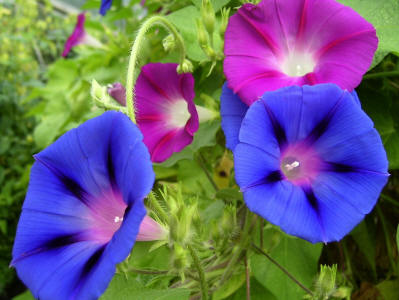(10/2) My kitchen window overlooks my gardens and recently I noticed a foxglove (digitalis purpura) with a tall bud spike, somewhat out of its normal springtime blooming. Watching it develop, I noticed that day-to-day it moved in a rather extreme bending action. Digging out my botany books, I was reminded that plants can move in a variety of ways. While we normally
think of plants as "rooted" to a spot, they are sneaky and do move around!
A familiar movement is in response to light. I think that is what my foxglove was doing, moving towards the morning and afternoon sunlight, a movement called "phototropism". Specialized cells known as auxins or plant hormones control growth by stimulating cell elongation. It is well accepted that phototropic bending of stems and roots results from cells on one side
elongating faster than cells on the other side, thus causing the plant to bend and change the direction of its growth in response to available sunlight.
Other less familiar plant movements can result from response to: temperature, "thermotropism", chemicals, "chemotropism", gravitational response, "geotropism" and response to water, "hydrotropism". While plants cannot detect water at a distance, if they do detect water in their nearby environment they are able to direct growth in the direction of a greater water
concentration. Some tree species have a reputation for finding their way into water pipes and sewer systems where they are simply taking maximum advantage of greater nearby water concentration. Plants also respond to water by rapidly growing when it is present and slowing growth when it is not.
 One type of plant movement more familiar to us is response to touch or external stimulus. Think of the mimosa tree or oxalis houseplant that folds its leaves when touched or disturbed. This type of movement is called "nastic" (from the Greek word meaning to press). Another familiar response to temperature, "thermotropism",
can be seen in winter when rhododendrons display downward leaf curl in extremely cold weather. This movement is thought to be a way of preventing water loss through stomata cells on leaf undersides. Perhaps the most familiar response to touch is that of a Venus Fly Trapís snapping shut when an insect touches two of its sensitive hair triggers. Other more benign movement
occurs in some flowers, such as Moss Rose (Portulaca), that close their petals at night.
One type of plant movement more familiar to us is response to touch or external stimulus. Think of the mimosa tree or oxalis houseplant that folds its leaves when touched or disturbed. This type of movement is called "nastic" (from the Greek word meaning to press). Another familiar response to temperature, "thermotropism",
can be seen in winter when rhododendrons display downward leaf curl in extremely cold weather. This movement is thought to be a way of preventing water loss through stomata cells on leaf undersides. Perhaps the most familiar response to touch is that of a Venus Fly Trapís snapping shut when an insect touches two of its sensitive hair triggers. Other more benign movement
occurs in some flowers, such as Moss Rose (Portulaca), that close their petals at night.
Some plants move their seeds. The native woodland celandine poppy and annual Vinca are familiar examples of plants that "move" or spread via explosive seedpods. Just barely touch a mature seedpod and watch how it will pop open flinging seeds away from the parent plant. Roots exhibit chemical response, "chemotropism", by concentrating their growth in regions of high
nutrient concentration and are sensitive to chemical compounds that can signify the presence of beneficial or harmful bacteria and fungi.
Anyone who has seen a morning glory coiling around a support has observed "thigmotropism" in action. This response occurs following a "force contact," in which the curving direction of a tendril in contact with a rigid surface is toward that surface, resulting in coiling around it. At the cellular level, a combination of cell elongation and changes in cell pressure are
responsible for generating growth along or around a solid object. Some tendrils will begin to curve within less than a minute of a contact stimulus. Cell membrane protrusions transmit a signal acted upon very rapidly by an unknown mechanism. Time-lapse photography has shown tendrils even waving around as though in search of a twining support.
Plants move and react to things in their environment in all kinds of ways and for all kinds of reasons. Think about some of these the next time you see a morning glory!